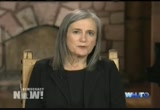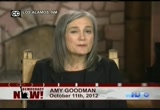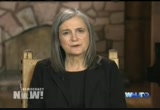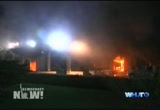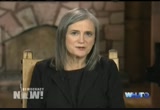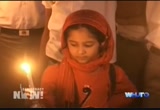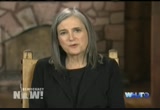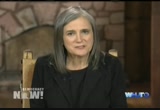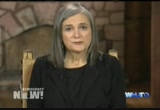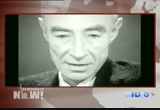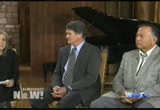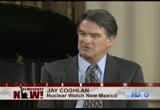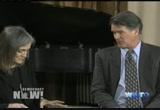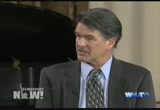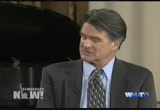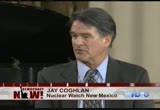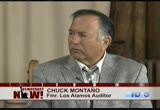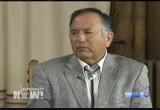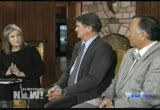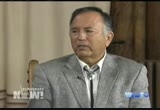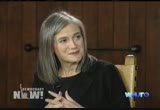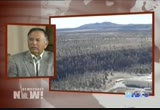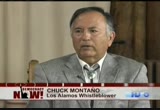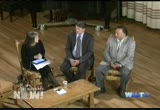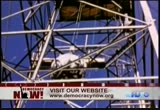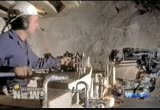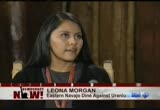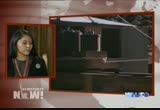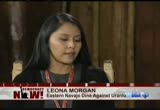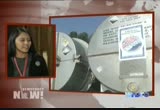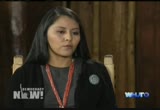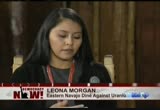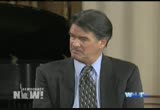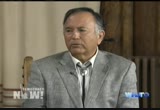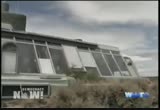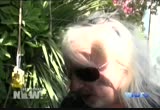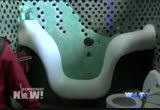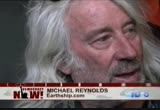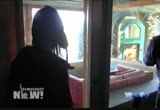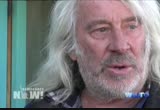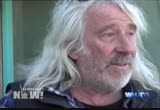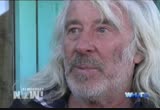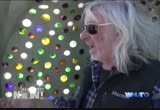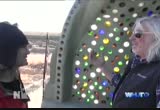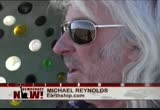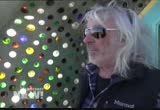tv Democracy Now WHUT October 11, 2012 6:00pm-7:00pm EDT
6:00 pm
10/11/12 10/11/12 [captioning made possible by democracy now!] >> from los alamos, new mexico, this is "democracy now!" [explosion] >> the familiar mushroom cloud hurling the deadly radiation to the heavens. >> in the special broadcast from just outside los alamos national laboratory, we look at the radioactive legacy of new mexico. the atomic bomb used in world war ii were designed and
6:01 pm
developed here. new mexico still plays a key role in maintaining the nation's massive nuclear arsenal. >> it is revitalizing its nuclear weapons production base, and again, the laboratories -- mark my words -- as the republicans already wrote, they are calling for or attempting to demand a "modern or had" that means a new designs. >> we will speak with jay coghlan of nuclear watch new mexico. and los alamos whistleblower chuck montaño. devastationt the uranium mining has had with leona morgan from navajo diné against uranium mining. and michael reynolds on how he is quitting radically sustainable living operations through worship biotecture. >> the soldiers and all of the
6:02 pm
armies and all of the world, if there were to put down their weapons epic of tools and start making sustainable housing for all the people in the world, life would just begin on this planet. >> all of that and more coming up. this is "democracy now!," democracynow.org, the war and peace report. i'm amy goodman. we're on the road in los alamos, new mexico, part of our 100-city tour. the u.s. military has deployed a secret task force to jordan to help respond to the ongoing violence in syria. "the new york times" reports a contingent of more than 150 planners and other specialists is tasked with helping jordanian forces handle incoming syrian refugees, prepare for syria's potential loss of control over its chemical weapons, and respond should the turmoil in
6:03 pm
syria spread more widely throughout the middle east. the mission also reportedly has discussed contingency plans to insulate jordan from the conflict, with talks of a u.s.- backed buffer zone along the syria-toward a murdeborder. the u.s. military presence in jordan comes just as the jordanian monarchy is facing its largest protests since the start of the arab spring. thousands of jordanians marched in the capital demanding economic opportunities and democratic reforms. turkey forced a syrian passenger airplane to land in and confiscated its cargo is tensions between the two countries continue to rise. the airplane was traveling from moscow to the syrian city of damascus, and there were unconfirmed reports military supplies including weapons parts were found on board. turkey's backed rebels opposed the regime of syrian president bashar al-assad and has been at odds with its neighbor since syrian shelling killed five turkish civilians last week. turkey has fired artillery
6:04 pm
across the border and ran to respond with more attacks as syrian fire continues. democratic and republican lawmakers clashed on wednesday at a house hearing into the security failures before the killings of four americans at the u.s. consulate in libya last month. republicans have accused the obama administration of failing to adequately protect the consulate, while democrats have accused republicans of cutting funding that would have paid for the absent security they now bemoan. on wednesday, the state department and knowledge rejecting appeals for more security at u.s. sites in libya in the months before the deadly attack. a former u.s. official in libya , lieutenant colonel daniel wood, said was secured operations in libya had been weak. >> the security in benghazi was a struggle and remained a struggle throughout my time there. the situation was uncertain and reports indicated it is getting worse. diplomatic security remained weak. in april, there was only one
6:05 pm
u.s. diplomatic security agent stationed there. struggle to obtain additional personnel, but there was never able. >> mitt romney has agreed to stop publicly discussing a former navy seal killed in the attack on u.s. consulate in libya following complaints from the victim's mother. glen doherty was one of four americans killed in the attack in benghazi one month ago today. in his campaign stump speech, romney has repeatedly recounted the story of meeting toward the at a function several years ago. >> i just learned a few days ago that he was one of the two former navy seals killed in benghazi. it broke my heart. he was a guy who lived in a homestead of massachusetts. we shared some passions for the kinds of things was interested
6:06 pm
in. >> mitt romney has invoked the killings in libya to criticize president obama's foreign policy. in response to romney's speech, doherty's mother said -- a friend of doherty's has also criticized romney's speech, saying that romney had forgotten meeting doherty several times at the event and that's doherty had found him to be insincere and stale. >> he approached of using his private gathering as basically a political venture to further his image. glen believed it to be very insincere and stale. >> is supreme court has heard arguments in a case challenging affirmative action in college admissions.
6:07 pm
a white student who says she was rejected from the university of texas because of her ethnicity brought the case, alleging she's the victim of discrimination. the challenge threatens an earlier decision that allowed public colleges and universities to consider race in order to improve diversity. the 2003 grutter v. bollinger ruling banned the use of point systems, but allowed for less direct methods of affirmative action. justice elena kagan has recused herself from the case, leaving it in the hands of the remaining eight justices. in yemen, the yemeni head of security at the u.s. embassy in sanaa has been assassinated. qassem aqlani was killed by an unknown assailant earlier today on his way to work. rallies and vigils have been held across pakistan in support of a 14-year-old activist for girls' education who was left seriously wounded in a targeted shooting. malalai yusufuzai was on her way home from school in an area of
6:08 pm
northwest pakistan when militants stopped the vehicle is traveling in. one man reportedly asked for her by name, and then shot her in the head and neck. the pakistani taliban has since claimed responsibility for the attack, saying it targeted her speaking out against them as well as against "islam and sharia." malalai yusufuzai has been celebrated worldwide for opposing the taliban's efforts to stop girls from attending school. on wednesday, hundreds of people gathered in several pakistani cities to condemn the attack. >> there is nothing more cowardly than for grown men to be attacking a small little girl of 14 years old. i condemn it and the strongest possible way, and i think there could be nothing more cowardly. >> malalai yusufuzai is said to be in stable condition after undergoing surgery to remove a bullet from her skull. the pakistani government has
6:09 pm
offered a bounty of over $100,000 for the capture of those who shot her. in russia, a court has freed one of three jailed members of the punk protest group pussy riot, but upheld prison sentences for the other two. in a case that has drawn international attention, the women were found guilty of hooliganism motivated by religious hatred after performing a punk prayer inside the cathedral the sort in the virgin mary to get rid of russian leader vladimir putin. yekaterina samutsevich was released on wednesday after lawyers argued she played less of a role in the protests because she was ejected from the cathedral before she could remove her guitar from its case. at a court hearing, yekaterina samutsevich apologized to church members offended by the actions in the intended target had been vladimir putin and russian elites. >> dear believers, we did not want to insult you. we never had such intentions.
6:10 pm
we went to the cathedral to voice our protest against the political elite of our country. >> the two other members to remain behind bars will be jailed for another two years. a federal appeals court has reinstated a montana law limiting donations to political campaigns. it was among several that have been struck down in montana the decision citing the supreme court's landmark citizens united ruling that allowed unlimited corporate spending on elections. this week, the ninth u.s. circuit court of appeals reversed an earlier challenge saying the judge who struck it down needs to provide his full reasoning for allowing unlimited money in political campaigns. today marks 10 years since the senate voted to authorize use of military force against iraq, paving the way for the u.s. invasion that would come less than six months later. among those to vote in favor
6:11 pm
were future democratic presidential candidates john kerry, hillary clinton, john edwards, and joe biden, who squares off against another lawmaker who also voted yes, congressmember paul ryan, in today's rise presidential debate. and those are some of the headlines. this is "democracy now!," democracynow.org, the war and peace report. i'm amy goodman. we are in our 100-city tour, here in los alamos, new mexico. yes, we are broadcasting from los alamos, the birthplace of the atomic bomb. we are here at the historic fuller lodge, built in 1928 as a boarding school for boys. gore vidal was one of the better known students here. the school was taken over by the u.s. government in 1943 to house the scientist for the manhattan project. the secret military program based here that produced the first u.s. nuclear weapon. the work was led by the physicist j. robert oppenheimer.
6:12 pm
this is oppenheimer speaking shortly after the first bomb was tested in southern new mexico in 1945. >> i have been asked whether in the years to come in will be possible to kill 40 million american people in the 20 largest american towns by the use of atomic bombs in a single night. i am afraid the answer to that question is yes. >> to robert oppenheimer would later say, "i am the shudder of world's." less than a month after the first atomic bomb test, the u.s. dropped a uranium bomb known as little boy over the japanese city of hiroshima, killing up to 130,000 people. three days later, fat man, a plutonium bomb, was detonated over nagasaki. later in his life, j. robert oppenheimer, often called the
6:13 pm
father of the atomic bomb, warned the public about its terrifying power. in a 1965 television broadcast he reflected on witnessing the first test nuclear explosion 20 years earlier. >> people laughed and people cried. i remember reading from the hindu scripture, "the destroyer of debt, a destroyer of worlds." i guess we all thought felt that way one another. >> to robert oppenheimer, developed the only two atomic bombs dropped on cities, nagasaki and hiroshima. today, los alamos national
6:14 pm
laboratory is the nation's foremost nuclear weapons lab. los alamos is only part of the nuclear story of new mexico. the state's long history of uranium mining on native american lands provides fuel for the front end of the nuclear industry. it is also published it also stores much of the radioactive waste from nuclear weapons and power plants. to talk more about this radioactive legacy that continues into the present, we're joined by three guests. jay coghlan is executive director of nuclear watchman mexico. chuck montaño is a former investigator and auditor at los alamos who faced retaliation after he blew the whistle on wasteful spending and fraud at the lab. and soon we will be joined by leona morgan, according to with a group, navajo diné against uranium mg. welcome all of you to "democracy now!"
6:15 pm
let's begin with you, jay. give us a tour of where we are right now. we are sitting in the fuller lodge. >> that is correct. to zero in nationally, here you are on this 100-city tour across the country, but the day you're not just in any town and she put it, we are in the birthplace of atomic and nuclear weapons. specifically, we're sitting in the historic fuller lodge. you invoke the name of j. r. oppenheimer, director of the manhattan project. i recall seeing another physicist who receive the nobel prize for physics, basically the man who figured out how the sun works through nuclear fusion. but approximately i would say about a dozen years ago before he died, he did a talk here in fuller lodge on the abolition of
6:16 pm
nuclear weapons, for which he was an advocate, speaking to los alamos employees. and afterwards, i remember him standing on the veranda here at fuller lodge shaking his head going, "they just don't understand." >> so what happens here now? >> right now, as we have both noted, this is the birthplace of atomic and nuclear weapons. what the public does not really understand is that the nuclear weapons business is very much on going. that funding for nuclear weapons programs within the department of energy is nearly 50% above the historic average of the cold war. and this is within the department of energy, not necessarily pentagon funding. but again, what i am attempting to underline is the very fact that despite the rhetoric that this country and others are
6:17 pm
working towards the future of world free of nuclear weapons, on the ground what is happening is that the u.s. is rebuilding the production side of its nuclear weapons complex. specifically here at los alamos, it is for the future expand production of the plutonium cores of the nuclear weapons. >> what is your problem with that? >> first of all, i am in doubt right advocate for the eventual abolition of nuclear weapons. as the president said in prague close to four years ago, we are going to have to maintain those weapons while we work toward eventual global disarmament. but what is happening the so- called life extension programs is the u.s. is extending the service life of its nuclear weapons on the order of three decades, while in going them with new military capabilities. the cost themselves are
6:18 pm
staggering. we're entering -- ending up with a clear weapons just refurbished cost more than their weight in gold. >> i want to go to president obama. it was soon after he came into office in 2009. >> so today, i state clearly and with conviction, america's commitment to seek the peace and security of a world without nuclear weapons. >> a world without nuclear weapons. jay coghlan? >> first of all, that is extremely laudable, but i do want to point out that this is truly a bipartisan thing. and who perhaps politically was the foremost abolitionist of all? it was ronald reagan. back in the late 1980's, he and gorbachev came within inches of
6:19 pm
a bilateral deal to begin to eradicate the world, to save the world from these nuclear- weapons. now having said that, the thing that essentially prevented the deal were the false claims made by the nuclear weapons laboratories. in this particular case, los alamos' sister laboratory in california, but false claims being made over star wars. that essentially is what prevented ronald reagan from friendly striking a al with gorbachev to rid the world of nuclear weapons. but i use this to point out the ongoing roll of the three nuclear weapons laboratories in this country, and the ignored it, and i would say unfavorable influence, that they have not only on national, but international nuclear weapons policies. >> who runs the lab now?
6:20 pm
>> specifically is being run for the government bought a limited liability corporation, which is for-profit, which is a change since 2006. but the two dominant partners in this limited liability corporation for the bechtel corp., a famous for attempting to take over the water system in bolivia against which there is a popular uprising, so there were kicked out. but again, it is the for-profit bechtel corporation and the university of california, something which is generally overlooked. since the beginning, the university of california has been absolutely central to both the development and ongoing continuation of nuclear weapons programs. >> chuck montaño, welcome to "democracy now!" you were tear the los alamos national laboratory for more than three decades -- you worked
6:21 pm
here at the los alamos national laboratory for more than three decades. you are a whistleblower. you left about a year ago. can you talk about what you did here, what you learned here, why you blew the whistle. >> my background is in audits and fraud investigation. i was naturally looking into the control and garment in the lab, looking for excessive spending, cost overruns, and of course, i am professionally down to report things as i find them -- bound to report things as i find them. the problem with the department of energy weapons complex is that auditors that really do their jobs are not really wanted because there is a concern about
6:22 pm
reporting things that could be an embarrass university of california, as jay pointed out. they ran a laboratory for some 60 years by itself until 2006 when it formed limited liability corporation and bechtel brought in the washington group and bwxt as industrial partners to run the los alamos lab. essentially, the university maintain a dominant position. my job was to look for fraud, waste, and abuse, internal weaknesses. what i discovered was when i reported things as i found them, my reports would be held up, would be watered down, sometimes they would not be issued. taxpayers pay the price, of course, when the laboratories, for example, has procurement arrangements to procure certain items at certain prices and then
6:23 pm
we find that vendors are actually selling items to lab employees' that they should not be purchasing, or at costs that are much higher than was contacted. when i brought those issues to the surface, i became a problem. auditors in general become a problem when they do that. back in 2003, in the aftermath, there were two seasonal criminal investigations brought in. >> the chinese american scientist hero los alamos who was investigated by the fbi, action before the 2001 attacks, if people are wondering what the fbi was doing before, saying he had given secrets to the chinese, which he adamantly disputed. >> he had not given secrets to anybody, actually. he was scheduled to be laid off along with about 1000 live in
6:24 pm
place in 1995. he had received what was referred to as an at risk notice. at the time when he downloaded data, code hit a marking on, he was contemplating have to search for another job. all of that eventually came out that that is what transpired. dr. lee is an interesting situation because the downloading of classified information is something i reported in mind and my reports. -- in one of my reports. the laboratory chose to ignore fixing the problem. had they fix that problem, and considerably the whole situation with dr. lee would not have occurred. there were also problems with missing tapes containing classified affirmation. one of my findings in this audit i did of classified computing of the lab was the laboratory did not have adequate control over the access of classified
6:25 pm
information. vaults were basically open to anyone who wanted to go in and they could remove items from the classified vaults without anybody, without a second person as a witness and without having dual controls in place. that was one of my audit findings. that was another example of for the laboratory chose to ignore some serious control issues that later led to some serious problems with the laboratory, have been missing tapes, computer tapes. >> can you talk about los alamos and the millionaires? >> i have lived in los alamos almost 20 years. i grew up in santa fe. we always all loss alamos as a very elite community, largely because it is very educated and because the laboratory pays very, very well. normally, new mexico was one of the poorest regions in the nation. as los alamos grew up and became a legitimate comty inin
6:26 pm
northern new mexico, they basically -- they grew into a community of millionaires. it is been reported repeatedly that all celis has the more most millionaires per capita than any community in the nation. -- los alamos has the most millionaires per capita than any community in the nation. people that come to work at the lab tend to stay until they retire, because retirement benefits are enviable. there is a line of people that would like to look awork at the lab, largely because of the salary and benefits. >> how were you retaliated against when he blew the whistle? >> the standard practice is to pull your responsibilities away. in my case, i had all my responsibilities removed, was put in a cubicle.
6:27 pm
i characterize it to a dilbert comic book episode, sitting in a cubicle with nothing to do for a period of nine months. that change only after i retained legal representation. in july 2004, the los angeles times did an article about the lab and the culture of the lab. in that article, made reference to my situation. that was the time i was in typical isolation, for eight months. even after the article came out, the laboratory did not change its practices with respect to keeping the isolated without any job assignments. >> what do you think is must import for people to know both about what happened to you and about what you expense? >> the taxpayer needs to understand that we are at the front lines in terms of the employees of these institutions. the auditors, in particular, and
6:28 pm
investigators. our job is to root out fraud, waste, and abuse and to identify weaknesses that could lead to fraud, waste, and abuse. when we are retaliated for doing our job, the taxpayer ultimately pays the price with higher costs, cost overruns. secrets that get lost in misplaced and do not get reported. help and environmental concern issues. who is at the front line if not the workers in terms of identifying risky practices that might contaminate the environment or expose workers to high risk, health and safety issues? whistleblowing protection is critical, especially for facilities like the los alamos national laboratory, because of the nature of the work that is done and the kind of materials they work with. >> will take a break and come back. we will be joined also by a guest from the navajo dine
6:29 pm
6:31 pm
>> this is "democracy now!," democracynow.org, the war and peace report. i'm amy goodman. we are broadcasting from los alamos, new mexico. this state is home to the navajo nation. for decades, they fought uranium mining on their land despite a mining moratorium on the troubled property, the company hydro resources ink is seeking approval to mine near the towns of crownpoint and church rock. uranium has been mined here for more than 50 years and the impact is still felt. the land is dotted with contaminated tailings and hundreds of abandoned mines that still not cleaned up. navajos have suffered from high cancer rates and respiratory problems. for more we're joined by leona morgan, according to with eastern navajo diné against uranium mining. their mission is to protect the water, air, land, and help of communities in areas impacted by uranium mines. we're talking about the dawn of the nuclear age.
6:32 pm
we're broadcasting from fuller lodge, where the scientists first came in 1943, part of the secret manhattan project to develop an atomic bomb. talk about where you come from, and how from that in 1943 relates to you. >> good morning. good afternoon tea people listening today in the afternoon. my name is leona. my family is from crownpoint area. by the way the first thing i think that is my dad was born in 1943. 1980's, thes to the navajo nation was mined for uranium for the sole purpose of protecting this country through nuclear weapons development. i guess the thing that really hits home is as indigenous peoples, we have been sacrificing and giving more than we even though the this
6:33 pm
country in order to advance its purposes. for example, los alamos is sitting on indigenous plants. the group talks about the agreement between the federal government and the santa clara pueblo, and one of the things told to them was is it is your patriotic duty to allow this entity to exist and that we will close it as soon as we win the war. our people and our language were used to create the navajo code, which also was something to help the united states to win the war. for us right now, we are still living with the effects from the mining of the 20th century, which the uranium boom had caused severe impacts to the economy, our health, and of course the environment. as indigenous peoples who live on the land and have all of our ways and traditions based within our sacred mountains,
6:34 pm
this is going to have a lasting impact not just to our culture and our health, but to future generations. >> explain how it is the uranium mines come into the navajo lands come into the reservations. >> back in the 1940's, there were no laws regulating the process, so several companies set up temporary llc's to extract uranium. as soon as they were done, when the profit was made, a drop in the uranium price in the 1980's led to hundreds of abandoned uranium mines all over the country and navajo lands. what happens was back then, the companies targeted areas where there was uranium and did whatever they could to access it, whether it was signing leases with communities or with individuals. in our area, we're dealing
6:35 pm
specifically with individuals. the navajo nation is divided into five regions. eastern navajo has a lot of what we call the checkerboard area. there are individual allotments. because of this individual ownership, they have the right to lease their land. what the company does is target individuals in our community and use this divide and conquer tactic. what they're doing is basically promising all these riches and basically monetary gains for an already poor community. a lot of our people do not even have running water or electricity. some of the individuals are dependent on this -- on these promises of a false economy and jobs and all these good things that they say they're going to do. but in reality, the project is
6:36 pm
only going to last five years and the rest of that will be restoration work, which depending on what their plan is, we don't believe they can do restoration. we're hoping the epa will use this opportunity to consider this old permit they gave the company called an aquifer exemption. back in the 1980's, they had obtained all their permits to do mining and have the permits this whole time, but have not started. one of the things they do, they basically don't give full lithification to the public. it is something that happens very often and it happens today, very common for the public to be unaware. >> can you talk about the effects of the uranium mines and what tailings are. >> there the radioactive waste from mining. we have been inundated by a
6:37 pm
number of conventional lines in males around northwestern new mexico. on navajo, we have 520 abandoned mines, but it is actually 520 clusters, so there are over 2000 individual sites of abandoned uranium mines for conventional mining occurred and they all have tailings waste that can go around and get into the water. we have livestock, we use animals breed of the soil becomes contaminated or the water becomes contaminated, through ingestion and other means, we also become -- those are some of the health effects and environmental effects, a fax to our food sources. nationally, there is no long- term solution for tailings. in church rock, there's a cleanup process going on at one of the mines. they're proposing to scrape up all of the waste and pile it on
6:38 pm
top of existing tailings waste and abandoned mine, and unaligned pile and proposing to leave it there in perpetuity. the community is calling for offset removal to regional depository. we do not want 520 permanent waste sites on the navajo nation. >> i want to get final comments come as you listen to leona morgan, jay coghlan, your final comments on where we stand today. president obama saying he wants to eliminate nuclear weapons in the world, what is happening here in the birthplace of the nuclear age here in los alamance. >> the first thing i would point out is we have very self interested institutions. it is not only a military industrial complex. i would call it a military industrial academic and congressional complex. where you have politicians
6:39 pm
across the country, but very much so here in new mexico, whose no. 1 job -- this is self- described -- is to bring appropriations funding to the nuclear weapons labs here in new mexico. notice i said labs in the plural. with another one approximately 60 miles south of us right now. two of the three nuclear weapons labs that this country has -- >> they're both los alamos national labs? >> an the third one is lawrence livermore, about 30 miles east of san francisco. >> it has been said if in mexico were to secede from the u.s., it would be the third bus powerful nuclear nation in the world. >> that is correct in terms of numbers. people who fly out of the albuquerque airport, if you know where to look, and it is very obscure, but if you know where
6:40 pm
to look, you can see as you take off about 2 miles out there is a repository that may have up to 3000 nuclear warheads. all the enough, it is a good thing they are there. bush sr. unilaterally retired a bunch of these weapons while there was a possible coup in moscow, but they are still awaiting [indiscernible] what we need to do instead of building up our arsenal, which we're doing, and extending the lives of the weapons, we need to be dismantling them and working off the -- >> chuck montaño, your final comment? >> i sympathize with what is happening in the navajo nation. my experience at the lab, i worked in safeguards when i first came into the lab. i know a lot of the material was improperly disposed of. in the early 1980's, they had
6:41 pm
open pits called area g. right before regulations kicked in that would require the lab to establish accounting records to keep track of what was been disposed of, the lab sent out a message lab-wide for all the different divisions to basically get all of the materials they wanted to get rid of and ship it over to area g and toss it into this open pit. that represented cleanup. rocky flats, where they produced plutonium pits, the department of energy, which has a very poor track record of holding contractors accountable, out rocky flats to get shot down 10 years ahead of schedule. billions of dollars short of what it would taken to clean it up. all they did at rocky flats was change the criteria in terms of what would be considered cleanup, and left in place the plutonium contamination that basically put denver at risk.
6:42 pm
we're on the verge of having that activity that was occurring at rocky flats moved here to los alamance, the pitch production part. i think people need to be concerned. finally, leona morgan, what you want to see. >> something you said earlier as you referred to as the nuclear fuel cycle. we like to call it a nuclear fuel chain. there is no cycle. there is no way to recycle the waste at the end. being at the front end of the nuclear chain, the uranium mining is extremely dangerous. we have already lived with the effects. basically, the us epa region 9 and 6 are the entities dealing with us, specifically we are working with region six. i want to say the epa and the navajo nation are at a critical time right now to prevent any future contamination to our drinking water.
6:43 pm
>> i want to teach you all for being with us, leona morgan, with eastern navajo diné against uranium mining. also, thank you very y much to e well-known anti-nuke activist jay coghlan, and to chuck montaño, an inspector here the los alamos national lab for more than 30 years who became a whistleblower. this is "democracy now!," democracynow.org, the war and peace report. i'm amy goodman. we are broadcasting from fuller lodge, where the manhattan project first came, the secret project of the u.s. government to develop the atomic bomb. stay with us. ♪ [music break]
6:44 pm
6:45 pm
developed here. some residents of new mexico are trying to atone for the history of war. we turn now to mike reynolds at the forefront of those recruiting more sustainable ways of living. it is the visionary once architect michael reynolds. he is creating radically sustainable living options through a process called earthship biotecture. the solar homes are created from natural and recycled materials including aluminum cans, plastic bottles, and used tires. these off the grid homes minimize their reliance on public utilities and fossil fuels by harnessing their energy from the sun and wind turbines. we were driving along from durango, colorado to taos, new mexico, when we saw this remarkable collection, a fascinating collection of structures scattered through the sage brush.tage
6:46 pm
but overall it's brought us into one of the first houses he built. he has been documented in a documentary called "garbage warrior." he give us a tour of one of the sustainable living homes he created. >> this is a buffer zone for the house to make it stay warmer, hold heat longer. the plants eat the sewage and provide food. it creates a whole different environment, a tropical environment out of the super cold desert, high desert. >> so the house is a jungle? >> is 50% a jungle. we just harvested bananas. this is talapia. you can fish here. my a-year-old grandson just caught a fish here and like 30 seconds. we grow protein. we have chickens out there.
6:47 pm
the idea with this is to show you can produce food enough to stay alive in your own home. >> what is in these pillars? >> this is just holding up this chamber appear that will be a hot tub. >> what are these materials? >> they are beer cans late in cement. beer cans and bottles. >> wide beer cans and bottles? to they are indigenous tand entire planet. this stays this temperature year-round a matter what. >> this is a warm, cool, moist -- >> in the wintertime, it feels warm, and in the summer, ifill school. the interior walls, most of them are tires. >> wide tires? >> they are indigenous to the entire planet. when you beat dirt into them,
6:48 pm
they hold temperature and stabilize the temperature, basically. so all of the back walls are made of tires? where do you get the tires? >> from the tire stores. they have to pay to take into the dumps. >> how many are there? >> we have a deal with the county. we have thousands of tires. >> my goodness. we are going into the bathroom right now. can you describe this to us? >> it is sort of in the jungle. it is a sculpted bathtub. the toilet flushes into the septic system, which runs back to the planters. >> why doesn't it stink? >> sue which does not have to stand if you understand biology. there are a lot of things in nature that are rancid, but nature takes care of it. we're just taking natures advice
6:49 pm
on how to deal with sewage rather than dumping raw sewage into a bay or ocean. >> does this break rules? >> yes. >> which rules as a break? >> every one of them. there are codes and rules, and there are variances. we have things in place. the code and rules are so stringent, so rigid that they are -- they make it so we have to evolve very slowly as we try to break these -- as we try to involve these rules. we're on a planet that is changing rapidly. humans have to evolve rapidly to be able to stay alive on this planet. the rules and codes keep us from evolving rapidly. i was pushing it too hard and that is why they took my license. i might make a mistake and might be a smell or something, but look at the mistakes they made with atomic energy. that is killing people and destroying continents.
6:50 pm
you are not far from los alamos. >> and i'm doing a helluva lot less damage. >> tells about the bedroom. >> look how many glass tables. three class spaces away from the outside. it is wrapped with -- this veterans day is comfortable all the time. >> and then we have a set of glass doors. >> another set of glass doors. another jumbo, and another set of glass doors. half of it is [indiscernible] >> the quote in the visitors' center. >> they made a movie about his call "garbage warrior." it did good in the film festival. i did not make it, someone made it and they spent four years following us around. it was being screened in toronto
6:51 pm
or vancouver or someplace. there were 900 people there. they gave the moving a standing ovation, then they started a question and answer. they got into discussing everything and why we were doing it. i was asked a question and i blurted it out, did not really think. what i blurted out was, "if all of these soldiers in all of the armies in all of the world were to put down their weapons and pick up tools and start making sustainable housing for all the people in the world, life would just began on this planet." i did not really know what i had said, but they wrote it down. >> and the material of here? >> scrap metal and wood. we use wood and cement. the buildings are 45% recycled material, i would say. >> tell me one more time about
6:52 pm
being near los alamos and what that means, the birthplace of the nuclear age. >> it really helped me get this law passed. new mexico was the state that destroyed 10,000 acres to test the atomic bomb. los alamos is over there doing major, major damage for i guess -- i guess it is for national security, basically, is what it is. i am sing from doing this, and i do this all over the world, that if everybody has everything they need, there won't be anybody fighting over anything. everybody will have what they need. this is a way to show people a path of how to get -- it is a lot of work. but it is a pathway to everything you need, not to pin it on corporations, fossil fuels, governments, will come to anything. you can get everything you need in this house. four people could stay here and be alive -- to live here and
6:53 pm
stay alive. >> what about in the u.s.? >> i went through long period of being a turd in a punch bowl. there is a stigma around garbage and sewage. we're making them into a building and into your living room it was not very popular at first, but now it is like the world is changing so fast that people are starting to recognize anything is better than second a car plant in japan that is destroying the whole continent. anything is better than the food that comes in the tropics that is grown -- trucks that is full of chemicals. the food here you can pick up and eat it. you can graze. at lunch, i go and pick tomatoes. you can live. you won't get fat, but you can live from these buildings without needing anything. if you could imagines the
6:54 pm
billions of people on this planet living without needing anything, it would be a whole different planet. >> mike reynolds, you lost your architectural license years ago? >> it was a controversy over breaking of rules, not following codes and regulations. i was sensing -- feeling a sense of urgency in trying to make sustainable housing happen faster. i worked with the officials, but some of them died and retard and things like that and you officials can in and i was breaking every rule in the book. >> why didn't you just talk? >> i did not want to stop. it turns out i can go further faster without being an architect. being an architect, you can be fined. a >> like what? >> not doing sewage the way it is supposed to be done in the regulation books, which is go into a septic tank and go out of a septic tank into the ground
6:55 pm
and contaminates the ground and ground waters. that is what is supposed to be done. sewage going into every city in the world has sewage going into rivers, bays, streams. we are trying to contain the sewage on site and treat it. that is not allowed. it is simply not allowed. you have to put it into the ground. furthermore, we are taking part of it through the living room. >> why the living room? >> well, all the rooms. it goes into botanical cells that grows plants, which gives oxygen and food. any part of the house is considered living. if the sewage is being treated in the house, that was taboo. >> where do you get the water from? >> from the sky and snowfall -- from the sky, rain and snowfall. we collected at the end of the
6:56 pm
botanical cell and flush the toilet with the same water, then that it's treated and is that in a septic system, and then used for landscaping. in the end, no water ever leaves the premises that came from the sky. >> if you're not an architect, what are you? >> i invented the word biotecture in some of architecture. architecture is really not standing up to the demands of the day. we wanted to create another profession that will address the demands of the day. architecture is too wrapped up in itself to -- consequently, architects are making buildings that require $18,000 worth of fuel a month to keep them comfortable. >> how much to people spent here, the utilities? >> if they pay over 100 -- >> $100 for what was tropics'
6:57 pm
$100 a year. >> how you get away with that? >> there are no utilities. everything, countering the national phenomenon of the earth, you have what you need. utilities are bad because they mine the earth for fuels and nuclear power plants, but just as bad as that is the infrastructure they used to deliver the utilities. they're all run by corporations and so on. the people are vulnerable. the people who live here are not vulnerable. they are a free people to exist no matter what happens to the economy or anything. >> how does this go back into the earth, as if they're calling -- houses go back into the earth. >> the earth is embracing the buildings, pretty much like a mother holds a baby. the earth is a source of temperature. just a few feet below the
6:58 pm
surface of the earth is a constant temperature. we are tapping into that temperature and actually i exhilarating that with the sun. >> in your building tall row house-like buildings. >> there is such a global interest in these, and one of the things they're saying is these are great for rural areas, but would not work in the urban circumstance. we're trying to demonstrate in due to increase story row mike f biotect. this is "democracy now!," democracynow.org, the war and peace report. i'm amy goodman. we were speaking on the road in taos. democracy now! is looking for feedback from people who appreciate the closed captioning. e-mail your comments to outreach@democracynow.org or mail them to democracy now! p.o. box 693 new york, new york 10013. [captioning made possible by democracy now!]
152 Views
IN COLLECTIONS
WHUT (Howard University Television) Television Archive
Television Archive  Open Access
Open Access  Television Archive News Search Service
Television Archive News Search Service 
Uploaded by TV Archive on

 Live Music Archive
Live Music Archive Librivox Free Audio
Librivox Free Audio Metropolitan Museum
Metropolitan Museum Cleveland Museum of Art
Cleveland Museum of Art Internet Arcade
Internet Arcade Console Living Room
Console Living Room Books to Borrow
Books to Borrow Open Library
Open Library TV News
TV News Understanding 9/11
Understanding 9/11
